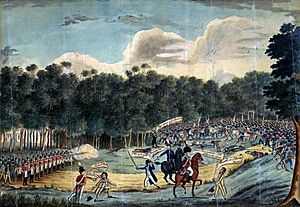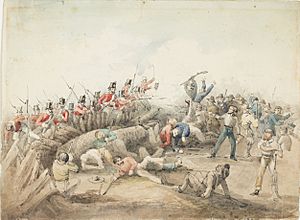British Army in Australia facts for kids
From the late 1700s to the end of the 1800s, the British Empire created and grew many colonies in Australia. These colonies included places like New South Wales, Van Diemen's Land (now Tasmania), Western Australia, South Australia, Victoria, and Queensland. Many of these started as penal settlements, which were places where convicts (people who had broken the law) were sent. All these settlements were built on land already lived on by Indigenous Australians.
To keep control of the many convicts, make sure British laws were followed, and fight in the Australian frontier wars (conflicts between settlers and Indigenous Australians), the British military, including the British Army, sent soldiers to Australia. From 1790 to 1870, more than 30 different British Army groups, with about 20,000 soldiers in total, were based in these Australian colonies.
Contents
- The New South Wales Corps (1790–1810)
- The 1810s: Conflicts and New Settlements
- The 1820s: Expanding Colonies and New Forces
- The 1830s: More Conflicts and Rebellions
- The 1840s: Protecting Settlements and Mining
- The 1850s: Gold Rush and Rebellions
- 1860 to 1870: Final Years of British Army Presence
- See also
The New South Wales Corps (1790–1810)
The first British settlement in Australia, Sydney, was started in 1788. It was protected by soldiers from the Corps of Royal Marines. In 1790, most of these marines were replaced by soldiers from the New South Wales Corps. This was a special army group created just for serving in Australia. They stayed in Australia until 1810.
During their time, these soldiers were involved in conflicts with Indigenous Australians and stopped convict uprisings. They also served in faraway places like Norfolk Island and Van Diemen's Land. Some officers from this group, like Francis Grose and John Macarthur, are remembered for their part in the Rum Rebellion of 1808. In this event, they removed Governor William Bligh from power. The New South Wales Corps was sometimes called the "Rum Corps" because its officers controlled the trade of rum, which was often used as money back then.
In 1795, European settlers and the Aboriginal people living along the Deerubbin (Hawkesbury) River had open conflicts. Lieutenant Governor William Paterson of the New South Wales Corps sent soldiers into the area. Several military actions took place, leading to the deaths of some Darug people. Two years later, soldiers near Parramatta had a fight with Bidjigal warriors led by Pemulwuy. The soldiers captured Pemulwuy and killed five of his companions during this Battle of Parramatta. More conflicts in the Hawkesbury region in 1805 led Governor Philip Gidley King to send soldiers to protect settlers. These patrols resulted in more Aboriginal deaths and the capture of an Indigenous leader named Musquito.
In March 1804, over 200 mostly Irish convicts at a prison farm in Castle Hill near Sydney rebelled. Major George Johnston of the New South Wales Corps led soldiers and loyal citizens to quickly defeat the rebellion at the Battle of Vinegar Hill. More than 15 convicts died, and nine were later hanged. Later that month, Governor Philip Gidley King sent ten soldiers and thirty prisoners to start a convict colony at the mouth of the Hunter River. This settlement became known as Newcastle.
The 1810s: Conflicts and New Settlements
During this time, soldiers from the 46th and 48th Regiments helped capture bushrangers (outlaws) like Michael Howe in Van Dieman's Land.
The Hawkesbury and Nepean Wars, which were ongoing conflicts between settlers and the Darug and Gandangara people, became more intense. In March 1816, a group of settlers was attacked near Silverdale by Aboriginal people, and four settlers were killed. Governor Lachlan Macquarie ordered a strong response to "strike them with terror." Macquarie sent three groups of soldiers from the 46th Regiment of Foot into the area. Captain James Wallis led one of these groups.
Wallis's soldiers searched the area around Appin and Minto. They learned that a group of Aboriginal people were camping near the Cataract River. On April 17, Wallis led a surprise attack on this camp. At least fourteen Aboriginal people died from gunshots or by falling off cliffs while trying to escape. Most of those who died were older men, women, and children. Two wanted men, Cannabaygal and Dunnell, were also killed. Governor Macquarie praised Wallis for his actions. This event became known as the Appin Massacre.
The 1820s: Expanding Colonies and New Forces
In March 1821, Captain Francis Allman of the 48th Regiment led soldiers and prisoners to start a convict settlement at the mouth of the Hastings River. This settlement was named Port Macquarie. Later that year, during a patrol, ten Irish soldiers from the 48th rebelled. A fight, called the Battle of Croppy's Hill, happened, and the rebellion was stopped, but one rebel died. Soldiers were also involved in conflicts with Aboriginal people near the Wilson River as new farms were set up.
In September 1824, fourteen soldiers from the 40th Regiment, led by Lieutenant Henry Miller, started the Moreton Bay penal colony. It was first on the Redcliffe Peninsula but moved in May 1825 to the Brisbane River because of crop problems and conflicts with local Aboriginal people. This new prison site became known as Brisbane.
During a time of martial law (when the military takes control) in 1824, soldiers from the 40th Regiment were sent to the Bathurst area of New South Wales to deal with the Wiradjuri people. This quickly ended the Bathurst War. The British Army in Australia did not have a mounted (horseback) division. After a conflict with the Wiradjuri people in 1825, it was decided to create one. The New South Wales Mounted Police was formed, made up of soldiers who volunteered. This group later became a civilian police unit in 1850.
In Tasmania, from 1824 to 1831, a violent conflict called the "Black War" happened between European settlers and Tasmanian Aboriginals. Soldiers from several regiments (39th, 40th, 57th, and 63rd) took part. They used different methods, including small groups that chased Aboriginal raiders and larger patrols that searched for and fought them. One strategy was the Black Line, where a long line of soldiers and armed settlers tried to push the remaining Aboriginal population into the Tasman Peninsula. This strategy, though difficult to carry out, helped end the Aboriginal resistance.
In September 1824, soldiers and Royal Marines set up a military outpost on Melville Island in northern Australia. It was called Fort Dundas and was the first attempt to colonize the tropical parts of the continent. The settlement was left in 1828 because of constant attacks by the local Tiwi people. A second attempt to set up a colony happened in 1827 on the nearby Cobourg Peninsula. Captain Henry Smyth led soldiers and Royal Marines to build Fort Wellington. Smyth used aggressive methods against the local Iwaidja people, including using cannons. After a violent incident involving Iwaidja people near the fort, Smyth was replaced by Captain Collet Barker, who improved relations. However, Fort Wellington was also abandoned in August 1829.
The 1830s: More Conflicts and Rebellions
In the early years of the Moreton Bay penal settlement, the 17th Regiment of Foot was involved in two documented conflicts with Aboriginal Australians. The first was on Moreton Island in July 1831, where Captain James Clunie and soldiers attacked a camp of Ngugi people. The second happened in December 1832 on Minjerribah, where six members of the local Nunukul tribe were killed by Captain Clunie and the 17th Regiment in a revenge attack.
In January 1834, soldiers from the 4th Regiment of Foot on Norfolk Island, led by Captain Foster Fyans, were ordered to stop a major convict uprising. In the conflict, five convicts and one soldier died. The head of the penal colony, Colonel James Morisset, allowed Fyans to use harsh punishments on the surviving leaders. Fourteen convicts were later sentenced to death and hanged.
In October 1834, after several years of conflict between settlers and the Pinjarup people along the Murray River in Western Australia, soldiers from the 21st Regiment of Foot were called in. Led by Governor James Sterling, the soldiers and mounted police were involved in a fight with the Pinjarup known as the Battle of Pinjarra. About forty Pinjarup people and one police captain died in this event.
In the mid-1830s, the Gringai people, who lived north of Newcastle, were in conflict with European settlers. In 1835, after some settlers were killed, Richard Bourke, the Governor of New South Wales, sent 50 soldiers from the 17th Regiment to the area. This military operation was led by Major William Croker, who was told to strongly stop the resistance. Croker's men returned after a month.
The 1840s: Protecting Settlements and Mining
In 1842, soldiers from the 96th Regiment were sent to the Port Lincoln settlement. Strong Aboriginal resistance there had caused many settlers to leave their land. Even though the soldiers had to retreat during a battle with the Battara people near Koppio, they gained control after several military actions.
The Governor of Western Australia, Charles Fitzgerald, led a group exploring for minerals near Champion Bay and the Murchison River in 1848. He was protected by soldiers from the 96th Regiment. Near the Bowes River, the group was surrounded by over 50 local Aboriginal people who threw spears and stones. The Governor, fearing for his group's safety, shot one man and was then speared in the leg. As the group retreated, the soldiers fired, and two more people were shot. A lead mining business soon started in the area, and a large group of 30 soldiers from the 99th Regiment was stationed at Champion Bay to guard the mines. In 1850, Lieutenant Elliot took 15 of these soldiers to build a fort at Quoin Bluff in Shark Bay to protect guano (bird droppings used as fertilizer) mining.
In 1849, soldiers from the 11th Regiment of Foot based in Brisbane carried out a night-time action against Aboriginal people camped at "York's Hollow". Led by Lieutenant George Cameron, the soldiers surrounded the sleeping camp and fired into it. Several Aboriginal people were wounded.
The 1850s: Gold Rush and Rebellions
In December 1854, soldiers from the 12th and 40th Regiments, led by Captain John Wellesley Thomas, helped stop a rebellion by gold miners during the Eureka Rebellion near Ballarat in Victoria. Several soldiers were killed during the conflict at the Eureka Stockade, including Captain Wise. About 34 miners also died.
1860 to 1870: Final Years of British Army Presence
In 1861, there were anti-Chinese riots by European gold miners at Lambing Flat in New South Wales. The military was sent to bring back order. In February, white miners violently forced Chinese miners off the goldfields. The local police arrested 15 rioters, but thousands more intimidated them into releasing the prisoners. Military help was requested, and 130 soldiers from the 12th Regiment, supported by about 100 mounted police and cannons, were sent from Sydney. The soldiers' presence brought calm, but after they left in early June, the problems started again. On June 30, thousands of European miners again attacked the Chinese quarters, with widespread assaults and looting. Two weeks later, when police arrested some rioters, the miners attacked the police. In the fight, several miners were killed, and the police left Lambing Flat. Military help was requested again, and 225 men were sent from Sydney. This group included 110 men from the 12th Regiment, with marines and Royal Artillery members. Again, the soldiers' presence alone kept the peace, and no more troubles happened.
The 18th Regiment of Foot and the Royal Artillery were the last British Army groups to be stationed in Australia. The last of these soldiers left Circular Quay on a ship called the Silver Eagle on August 28, 1870. Many soldiers left without permission in the week before their departure.
See also



